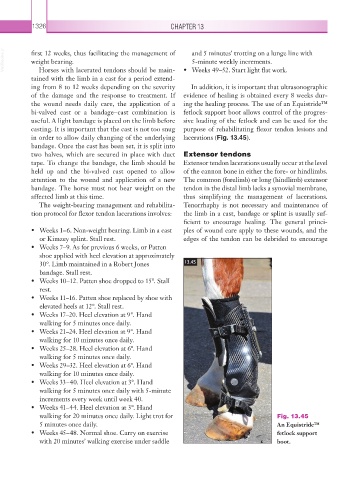Page 1351 - Equine Clinical Medicine, Surgery and Reproduction, 2nd Edition
P. 1351
1326 CHAPTER 13
VetBooks.ir first 12 weeks, thus facilitating the management of and 5 minutes’ trotting on a lunge line with
5-minute weekly increments.
weight bearing.
Horses with lacerated tendons should be main-
tained with the limb in a cast for a period extend- • Weeks 49–52. Start light flat work.
ing from 8 to 12 weeks depending on the severity In addition, it is important that ultrasonographic
of the damage and the response to treatment. If evidence of healing is obtained every 8 weeks dur-
the wound needs daily care, the application of a ing the healing process. The use of an Equistride™
bi-valved cast or a bandage–cast combination is fetlock support boot allows control of the progres-
useful. A light bandage is placed on the limb before sive loading of the fetlock and can be used for the
casting. It is important that the cast is not too snug purpose of rehabilitating flexor tendon lesions and
in order to allow daily changing of the underlying lacerations (Fig. 13.45).
bandage. Once the cast has been set, it is split into
two halves, which are secured in place with duct Extensor tendons
tape. To change the bandage, the limb should be Extensor tendon lacerations usually occur at the level
held up and the bi-valved cast opened to allow of the cannon bone in either the fore- or hindlimbs.
attention to the wound and application of a new The common (forelimb) or long (hindlimb) extensor
bandage. The horse must not bear weight on the tendon in the distal limb lacks a synovial membrane,
affected limb at this time. thus simplifying the management of lacerations.
The weight-bearing management and rehabilita- Tenorrhaphy is not necessary and maintenance of
tion protocol for flexor tendon lacerations involves: the limb in a cast, bandage or splint is usually suf-
ficient to encourage healing. The general princi-
• Weeks 1–6. Non-weight bearing. Limb in a cast ples of wound care apply to these wounds, and the
or Kimzey splint. Stall rest. edges of the tendon can be debrided to encourage
• Weeks 7–9. As for previous 6 weeks, or Patten
shoe applied with heel elevation at approximately
30°. Limb maintained in a Robert Jones 13.45
bandage. Stall rest.
• Weeks 10–12. Patten shoe dropped to 15°. Stall
rest.
• Weeks 11–16. Patten shoe replaced by shoe with
elevated heels at 12°. Stall rest.
• Weeks 17–20. Heel elevation at 9°. Hand
walking for 5 minutes once daily.
• Weeks 21–24. Heel elevation at 9°. Hand
walking for 10 minutes once daily.
• Weeks 25–28. Heel elevation at 6°. Hand
walking for 5 minutes once daily.
• Weeks 29–32. Heel elevation at 6°. Hand
walking for 10 minutes once daily.
• Weeks 33–40. Heel elevation at 3°. Hand
walking for 5 minutes once daily with 5-minute
increments every week until week 40.
• Weeks 41–44. Heel elevation at 3°. Hand
walking for 20 minutes once daily. Light trot for Fig. 13.45
5 minutes once daily. An Equistride™
• Weeks 45–48. Normal shoe. Carry on exercise fetlock support
with 20 minutes’ walking exercise under saddle boot.

